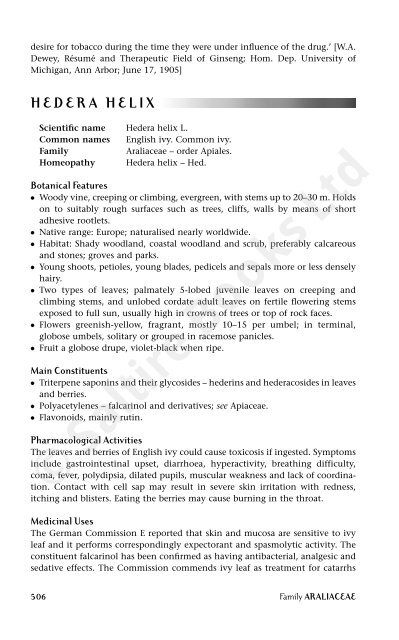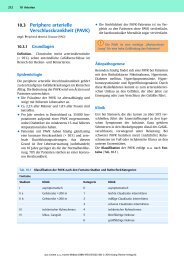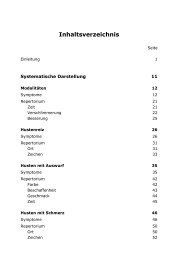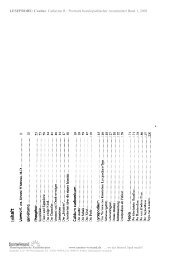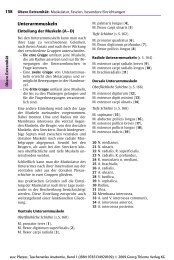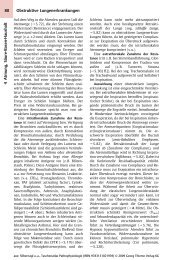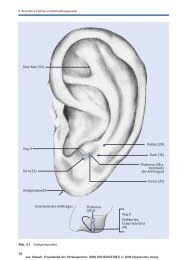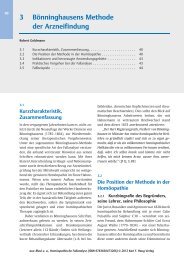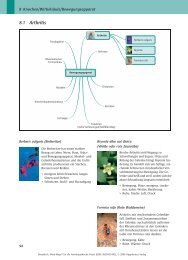alphabetical index of plant families and groups - Sunrise Versand
alphabetical index of plant families and groups - Sunrise Versand
alphabetical index of plant families and groups - Sunrise Versand
Create successful ePaper yourself
Turn your PDF publications into a flip-book with our unique Google optimized e-Paper software.
desire for tobacco during the time they were under influence <strong>of</strong> the drug.’ [W.A.<br />
Dewey, Résumé <strong>and</strong> Therapeutic Field <strong>of</strong> Ginseng; Hom. Dep. University <strong>of</strong><br />
Michigan, Ann Arbor; June 17, 1905]<br />
HEDERA HELIX<br />
Scientific name Hedera helix L.<br />
Common names English ivy. Common ivy.<br />
Family Araliaceae – order Apiales.<br />
Homeopathy Hedera helix – Hed.<br />
Botanical Features<br />
� Woody vine, creeping or climbing, evergreen, with stems up to 20–30 m. Holds<br />
on to suitably rough surfaces such as trees, cliffs, walls by means <strong>of</strong> short<br />
adhesive rootlets.<br />
� Native range: Europe; naturalised nearly worldwide.<br />
� Habitat: Shady woodl<strong>and</strong>, coastal woodl<strong>and</strong> <strong>and</strong> scrub, preferably calcareous<br />
<strong>and</strong> stones; groves <strong>and</strong> parks.<br />
� Young shoots, petioles, young blades, pedicels <strong>and</strong> sepals more or less densely<br />
hairy.<br />
� Two types <strong>of</strong> leaves; palmately 5-lobed juvenile leaves on creeping <strong>and</strong><br />
climbing stems, <strong>and</strong> unlobed cordate adult leaves on fertile flowering stems<br />
exposed to full sun, usually high in crowns <strong>of</strong> trees or top <strong>of</strong> rock faces.<br />
� Flowers greenish-yellow, fragrant, mostly 10–15 per umbel; in terminal,<br />
globose umbels, solitary or grouped in racemose panicles.<br />
� Fruit a globose drupe, violet-black when ripe.<br />
Main Constituents<br />
� Triterpene saponins <strong>and</strong> their glycosides – hederins <strong>and</strong> hederacosides in leaves<br />
<strong>and</strong> berries.<br />
� Polyacetylenes – falcarinol <strong>and</strong> derivatives; see Apiaceae.<br />
� Flavonoids, mainly rutin.<br />
Pharmacological Activities<br />
The leaves <strong>and</strong> berries <strong>of</strong> English ivy could cause toxicosis if ingested. Symptoms<br />
include gastrointestinal upset, diarrhoea, hyperactivity, breathing difficulty,<br />
coma, fever, polydipsia, dilated pupils, muscular weakness <strong>and</strong> lack <strong>of</strong> coordination.<br />
Contact with cell sap may result in severe skin irritation with redness,<br />
itching <strong>and</strong> blisters. Eating the berries may cause burning in the throat.<br />
© Saltire Books Ltd<br />
Medicinal Uses<br />
The German Commission E reported that skin <strong>and</strong> mucosa are sensitive to ivy<br />
leaf <strong>and</strong> it performs correspondingly expectorant <strong>and</strong> spasmolytic activity. The<br />
constituent falcarinol has been confirmed as having antibacterial, analgesic <strong>and</strong><br />
sedative effects. The Commission commends ivy leaf as treatment for catarrhs<br />
506 Family ARALIACEAE


